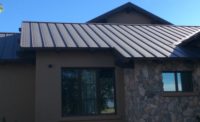Smog-Eating Tile

Titanium Dioxide, the photo-catalyst that instigates the smog-eating tile’s air-cleaning process, is a proven de-pollutant that is both naturally occurring and safe for humans.Photos courtesy of Boral Roofing.

The special cementitious coating used for the surface of the tile is harder and less porous than regular tiles and on this basis is likely to give a long service life.

Concrete roof tile helps to keep a home cooler in summer months and warmer in winter months.



It’s now possible for a roof to reduce harmful, disease-causing pollutants from the air. Boral is the first to introduce this application to roofing products in the American building industry — BoralPure™ Smog Eating Tile. Over one year, 2,000 square feet of the new tiles can destroy approximately the same amount of nitrogen oxide as a car produces from being driven 10,800 miles. (1)
The photocatalyst in BoralPure Smog Eating Tile naturally oxidizes harmful airborne pollutants, helping clean the air. This revolutionary roof tile includes a micro-mortar surface with the key ingredient Titanium Dioxide, a photocatalyst, which is activated by the UV content in daylight. The active surface interacts with harmful nitrogen oxides in the air and helps convert them into calcium nitrates. When it rains, the calcium nitrates are washed off the roof.
The product has been specified in a number of housing projects and the reaction has been very positive.
“The real impact is that it takes that car off the road,” said KB Home Southern California President Steve Ruffner. “Reaction to the roofs has been so positive that we decided to offer them as an option at all of our new developments in California. Buyers like it and it’s the right thing to do.”
Why Does it Matter?
Smog taints the skylines of many of the world’s great cities, covering blue skies with a brown haze. While unattractive to view, the harm in smog runs much deeper. The World Health Organization recently estimated that 2.4 million people worldwide die annually from causes directly attributed to air pollution. Weighing in closer to home, the American Lung Association in its prominent 2011 “State of the Air” study found that more than 154 million (over half the nation) still suffer pollution levels that are too often dangerous to breathe.
The American Lung Association cites numerous health concerns and conditions caused by smog. They include premature births, infant deaths, chronic obstructive pulmonary disease, allergies, asthma, lower lung function, premature death, lung cancer, heart disease and heart attacks. These diseases and conditions can often be fatal. The bottom line is that when you reduce the levels of smog in the air, you raise the life expectancy of the people breathing that air.
Titanium Dioxide
Titanium Dioxide, the photo-catalyst that instigates the smog-eating tile’s air-cleaning process, is a proven de-pollutant that is both naturally occurring and safe for humans. The compound is commonly found in a number of items that we interact with daily such as paints, cosmetics toothpaste, and white roof membranes. It is now also being used in hospitals on operating room walls for sterilization purposes.
Titanium Dioxide’s de-polluting and de-soiling capabilities are proven. The notable European Project PICADA studies demonstrate the capabilities of TiO2 as a key ingredient in coatings. Conducted by a consortium of leading European contractors, manufacturers and research centers, the PICADA Project fully demonstrates Titanium Dioxide’s de-polluting properties against Nitrogen Oxide and Volatile Organic Compounds (VOCs), the key ingredients of smog.
“In the studies conducted in Europe where they actually applied it (Titanium Dioxide) to roadways the air was measurably cleaner,” notes President Michael Chusid of Chusid Associates, a marketing and technical consultancy on building products. “It works.”
In addition to its ability to reduce the formation of smog molecules, the Titanium Dioxide coating on the smog-eating tile adds another benefit to homeowners with this concrete roof solution. It is a stay clean technology that can break down organic substances that commonly accumulate on roof surfaces. Substances such as mold and algae are destroyed when UV light hits the roof surface. The visible organic materials on the roof then become transparent maintaining the appearance of the structure.
A Sustainable, Lifetime Product
While smog-eating tile provides health benefits with its coating, the base material of the tile also offers many efficiency and earth-saving benefits. Concrete tiles are made of locally sourced raw mineral materials, a mixture of sand, water, and cement and they have the inherent energy benefits of high thermal mass, emissivity, reflectivity and an insulating air space between the tile and the deck. It is an energy efficient solution that helps homeowners achieve up to 22 percent in energy costs. This is according to the Steep-slope Assembly Testing of Clay and Concrete Tile, Oak Ridge National Laboratory. The results vary based on the profiles of the tiles installed.
Concrete roof tile helps to keep a home cooler in summer months and warmer in winter months. These temperature regulating qualities reduce a homeowner’s need for heat and air conditioning, providing valuable energy cost savings.
The concrete tile is also a lifetime product requiring little maintenance (we also offer limited lifetime warranties). The special cementitious coating used for the surface of the tile is harder and less porous than regular tiles and on this basis is likely to give a long service life. Concrete roofing also protects against inclement weather and fire. And when a homeowner decides to replace the roof for whatever reason, Boral’s concrete tile is designed to be recyclable as a material to create new structures and roads and reduced landfill waste. And in an added commitment to the planet, Boral produces its concrete roof solutions in eco-conscious manufacturing plants. Smog eating tile may potentially qualify for a point under LEED’s Innovation in Design credit.
With installation processes in line with other tile roof solutions and the sustainability, energy efficiency, cost savings, lifetime solution and air cleaning qualities, why wouldn’t more builders and homeowners turn to smog-eating tile? The benefits are too great to be ignored and the technology represents one real way for roofers, builders, architects and owners to help reduce our smog footprint as well as some of the adverse effects of smog.
(1)U. S. Environmental Protection Agency Vehicle Program Tier 2 Standard; Daylight hours based on Los Angeles, California; Laboratory air-purification performance testing per ISO 22197-1: 2007; results may vary depending on geographic location, weather and other factors
Looking for a reprint of this article?
From high-res PDFs to custom plaques, order your copy today!








